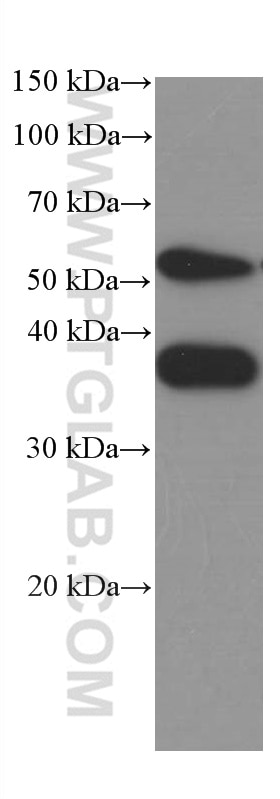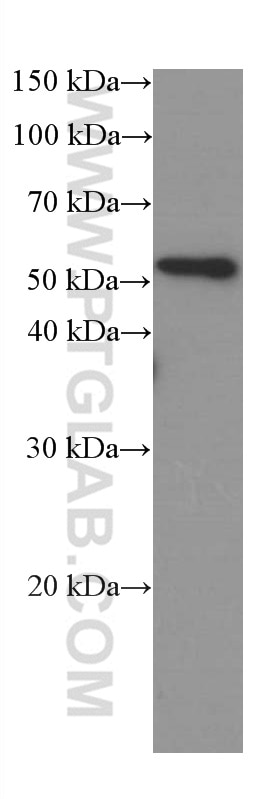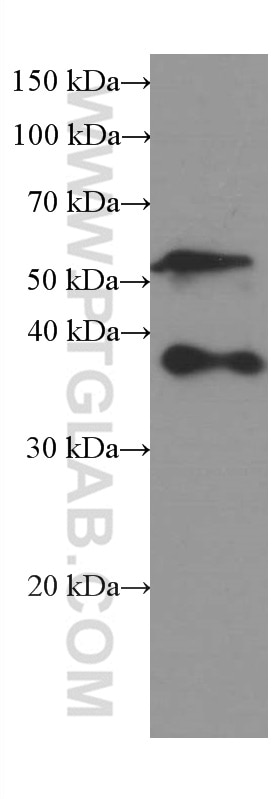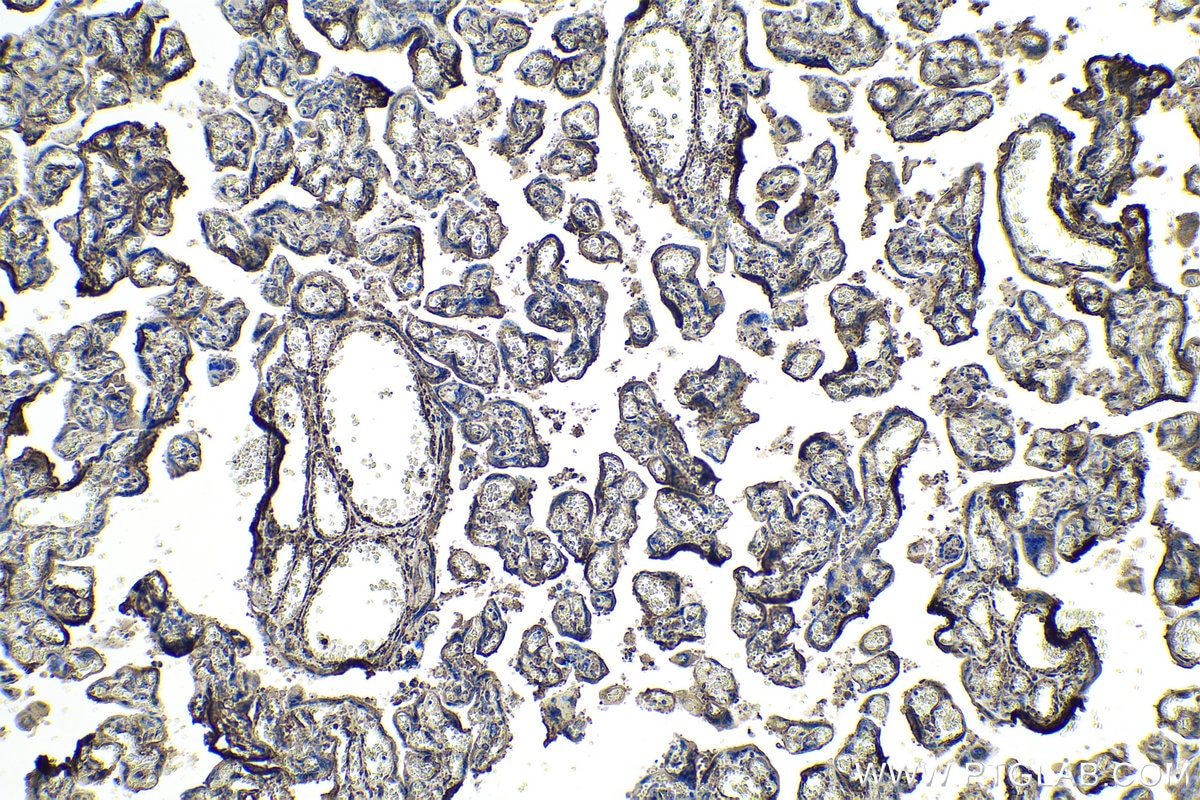Anticorps Monoclonal anti-SPARC
SPARC Monoclonal Antibody for WB, IHC, IF/ICC, ELISA
Hôte / Isotype
Mouse / IgG2a
Réactivité testée
Humain, rat et plus (1)
Applications
WB, IHC, IF/ICC, ELISA
Conjugaison
Non conjugué
CloneNo.
1A2C1
N° de cat : 66426-1-Ig
Synonymes
Galerie de données de validation
Applications testées
| Résultats positifs en WB | cellules A375, cellule NCCIT, tissu testiculaire humain |
| Résultats positifs en IHC | tissu placentaire humain, il est suggéré de démasquer l'antigène avec un tampon de TE buffer pH 9.0; (*) À défaut, 'le démasquage de l'antigène peut être 'effectué avec un tampon citrate pH 6,0. |
| Résultats positifs en IF/ICC | cellules C6, |
Dilution recommandée
| Application | Dilution |
|---|---|
| Western Blot (WB) | WB : 1:2000-1:10000 |
| Immunohistochimie (IHC) | IHC : 1:1000-1:4000 |
| Immunofluorescence (IF)/ICC | IF/ICC : 1:400-1:1600 |
| It is recommended that this reagent should be titrated in each testing system to obtain optimal results. | |
| Sample-dependent, check data in validation data gallery | |
Applications publiées
| KD/KO | See 1 publications below |
| WB | See 7 publications below |
| IHC | See 1 publications below |
Informations sur le produit
66426-1-Ig cible SPARC dans les applications de WB, IHC, IF/ICC, ELISA et montre une réactivité avec des échantillons Humain, rat
| Réactivité | Humain, rat |
| Réactivité citée | Humain, souris |
| Hôte / Isotype | Mouse / IgG2a |
| Clonalité | Monoclonal |
| Type | Anticorps |
| Immunogène | SPARC Protéine recombinante Ag7390 |
| Nom complet | secreted protein, acidic, cysteine-rich (osteonectin) |
| Masse moléculaire calculée | 35 kDa |
| Poids moléculaire observé | 38 kDa, 52 kDa |
| Numéro d’acquisition GenBank | BC004974 |
| Symbole du gène | SPARC |
| Identification du gène (NCBI) | 6678 |
| Conjugaison | Non conjugué |
| Forme | Liquide |
| Méthode de purification | Purification par protéine A |
| Tampon de stockage | PBS with 0.02% sodium azide and 50% glycerol |
| Conditions de stockage | Stocker à -20°C. Stable pendant un an après l'expédition. L'aliquotage n'est pas nécessaire pour le stockage à -20oC Les 20ul contiennent 0,1% de BSA. |
Informations générales
SPARC, also known as ON (Osteonectin) or BM-40 (Basement-membrane protein 40), is an extracellular glycoprotein with the calculated molecular mass of 35 kDa and the apparent molecular mass of 40-43 kDa and 50 kDa (PMID: 7495300, 12365801). SPARC belongs to a group of matricellular proteins defined as secreted components that do not contribute directly to the formation of structural elements but serve to modulate cell-matrix interactions and cellular functions (PMID: 7542656; 12231357). SPARC is expressed at high levels in bone tissue, is distributed widely in many other tissues and cell types, and is associated generally with tissues undergoing morphogenesis, remodeling and wound repair (PMID: 10567433). It elicits changes in cell shape, inhibits cell-cycle progression, and influences the synthesis of extracellular matrix (PMID: 12721366). Altered expression of SPARC has been reported in a variety of cancers, which include breast, ovarian, colorectal, and pancreatic cancer as well as melanoma and glioblastomas (PMID: 18849185).
Protocole
| Product Specific Protocols | |
|---|---|
| WB protocol for SPARC antibody 66426-1-Ig | Download protocol |
| IHC protocol for SPARC antibody 66426-1-Ig | Download protocol |
| IF protocol for SPARC antibody 66426-1-Ig | Download protocol |
| Standard Protocols | |
|---|---|
| Click here to view our Standard Protocols |
Publications
| Species | Application | Title |
|---|---|---|
Adv Sci (Weinh) Elevated SPARC Disrupts the Intestinal Barrier Integrity in Crohn's Disease by Interacting with OTUD4 and Activating the MYD88/NF-κB Pathway | ||
Int J Cancer Tissue-resident CXCR4+ macrophage as a poor prognosis signature promotes pancreatic ductal adenocarcinoma progression | ||
Br J Cancer Inactivation of 3-hydroxybutyrate dehydrogenase type 2 promotes proliferation and metastasis of nasopharyngeal carcinoma by iron retention. | ||
Front Endocrinol (Lausanne) Secreted Protein Acidic and Rich in Cysteine Mediates the Development and Progression of Diabetic Retinopathy. | ||
Exp Cell Res Sorafenib derivatives-functionalized gold nanoparticles confer protection against tumor angiogenesis and proliferation via suppression of EGFR and VEGFR-2. | ||
Pathol Res Pract Downregulation of NEBL promotes migration and invasion of clear cell renal cell carcinoma by inducing epithelial-mesenchymal transition |







